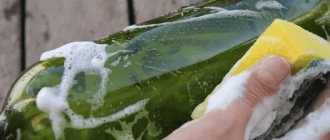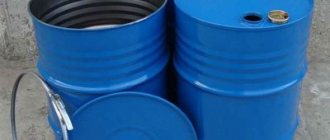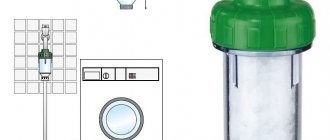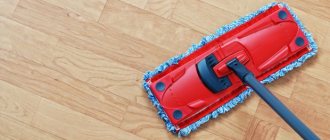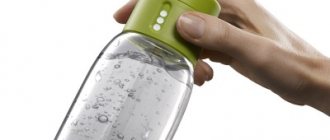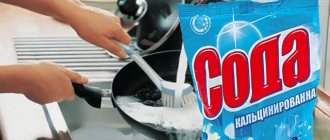Plastic containers are very convenient for storing water supplies. It is lightweight, costs much less than its metal counterparts, but there is a problem - plastic bottles or canisters are very difficult to wash. It is almost impossible to get to the bottom of the vessel to wash off the green residue, but there are life hacks that will help you quickly and efficiently cope with this task.
How to mechanically clean a canister from green residue after water
A plastic bottle or canister is very convenient to use: they are light in weight and have a convenient design, making them quite easy to use. However, sometimes green deposits or mold appear at the bottom of the containers. This makes plastic containers unsuitable for drinking water.
To get rid of greens, algae and other contaminants, use a simple cleaning method:
- Pour baking soda into a canister (approximately 250-300 g per 20 liters) and add a little liquid.
- Leave for several hours.
- Throw a cloth into the container and vigorously shake the canister for 10 minutes.
- Rinse the bottle thoroughly until all remaining soda and contaminants are removed.
other methods
You can wash a plastic canister using other methods:
- Pour wheat grain, beans or millet into a container and add a little water. Shake the bottle vigorously and then rinse well. To enhance the effect, you can add a little liquid soap.
- Throw a few metal dish brushes into the bottom. Add detergent and some water. Shake the bottle vigorously and then wash it.
- Pour some dish soap into the canister and add a couple of tablespoons of coarse sea salt. If necessary, add a little water. Shake the canister vigorously for 5 minutes until the surface is completely clean. Leave the container with detergent inside for 10-30 minutes, and then wash and dry well.
Where do you fill 20 liter bottles with water?
I mostly buy water from vending machines for 4 rubles a liter of water, next to the house in the neighboring yard. To those who still don’t know, everywhere in the city of Kazan, combining several courtyards, there are automated devices for independently collecting clean drinking water.
How to top up your balance in the terminal, based on the number of liters of the container you want to fill, press the fill button, insert the bottle and then water automatically pours out, filling the required amount of water into the container. Today I buy a 19 liter bottle for 76 rubles.
In principle, physical exercise for the body is close to home, but due to the long absence of washing, it turns out that such everyday tasks appear. So, I decided for myself the issue of cleaning mold inside plastic containers and recommend it to everyone, so that they, in turn, can clean their glass containers too.
This method also works well for glass containers. Removes green deposits, wine residues, dirt, much worse than in plastic bottles, where you can’t get through with a brush. Only a good shake with the grains inside the container provided a way out of this situation.
I would like to conclude my note on cleaning the bottle from green deposits. Enjoy using this method of cleaning containers and not just plastic ones. Relatively safe to clean, especially for food bottles, it's also cheap. You can leave millet or rice as a reserve if you don’t eat it, although we love rice in our family and make pilaf from it.
Share this note on social networks with your friends, let them benefit from it, and don’t forget to subscribe to other Lifehack articles. Have a nice day everyone, clean bottles, good health, see you soon!
Repost and win a laptop!
Every month on the 1st of the month iBook.pro gives away gifts.
- Click on one of the social buttons. networks
- Get a personal coupon
- Win a LENOVO or HP laptop
—>
LENOVO or HP from 40-50 TR, 8-16GB DDR4, SSD, 15.6″ screen, Windows 10
How to wash greens in a water bottle using household chemicals
Mold can be removed using chemicals. This method is suitable for large containers (10 liters or more) that are intended for storing process water .
Cleaning procedure:
- Pour in concentrated hydrochloric acid solution.
- Close the lid and shake the bottle well for 5 minutes.
- Rinse the container with clean running water.
- If necessary, repeat the manipulation again.
You can wash plastic bottles using special cleaning powders and pipe cleaning liquids:
- Pour your chosen cleaning product into the container.
- Leave for 15-20 minutes and pour out the contents.
- Wash the bottle well with running water.
Do not use containers that have been washed with aggressive cleaning agents to store drinking water. The liquid absorbs the remaining powder or gel and becomes hazardous to health. If you drink such water, it can lead to severe intoxication.
You can clean the canister using the “grandmother’s” method, which is based on the use of beneficial herbs. For this purpose, nettle or yarrow are used. Place the herbs in a canister, fill with water, shake a little and leave for several hours. Then rinse the container well and dry.
Home remedies that are safe for health will also help you wash a plastic bottle:
- Pour citric acid solution (100 g per 20 liters of water) into a container and leave overnight. In the morning, wash everything with running water and dry well.
- Coca-Cola will help remove mold. Pour the sweet carbonated drink into a container and add citric acid. Leave for a few minutes and then rinse well.
- Add 2-4 tbsp. l. soda and add vinegar. Wait for the chemical reaction to complete and wash the container thoroughly.
You can clean mold from a canister at home. However, to avoid having to look for ways to remove greens, wash and dry the container well after each use.
How to dry properly
To prevent mold from appearing inside the bottle, dry it well before storing. There are several drying methods depending on the container material.
Glass
For drying, paper that absorbs moisture well or waffle towels is suitable. Roll a napkin or sheet of paper into a tube and place it in a container so that one end sticks out of the neck. Replace wet sheets with dry ones until the moisture completely disappears.
Plastic
Turn the container upside down and place it so that air enters the neck.
Video on the topic
Watch videos in which experienced specialists will tell you how to properly clean a plastic bottle from dirt:
Young mother, wife and part-time freelancer. Being a lawyer by training, I am accustomed to collecting and providing the most complete and reliable information. Constantly improves in the professional field and strives for personal growth and development.
Found a mistake? Select the text with the mouse and click:
Fresh lemon is not only suitable for tea: clean dirt from the surface of an acrylic bath by rubbing with half a cut citrus, or quickly wash the microwave by placing a container of water and lemon slices in it for 8-10 minutes at maximum power. The softened dirt can simply be wiped off with a sponge.
Using cereal
The method is easy to use, but requires physical effort. This method is suitable if you urgently need to clean the eggplant from mold, but you have nothing on hand except cereal. Mix it with water and shake the bottle. The main thing to remember is that the place that needs to be cleaned is at the lowest point. In this method, you can use any cereal that is available, but priority is given to buckwheat, rice, and millet.
Alkali treatment
To clean plastic bottles, you will need baking soda and water. Pour soda into a container (for a 20-liter eggplant you will need 200 g of soda) and add a small amount of water to make a thick porridge. Then close the lid of the container and leave for several hours for the reaction to appear. To enhance the cleaning process, you can shake the container several times. At the end, the cleaned plastic containers should be rinsed with running water.
Soda is an excellent antiseptic, so it will clean the container not only of visible plaque and dirt, but also of harmful bacteria.
Using newspapers
Suitable if the bottle is not very dirty and cleaning it does not require much effort. Take unwanted newspaper or thick paper, tear it and roll it into many small balls. Then put them in a container that needs to be washed and add water.
Shake the bottle and constantly turn it for 5 minutes. If the contamination is strong, then you should add soda, pouring it with water, thereby turning it into a thick porridge. Then add crumpled newspaper to the mixture and pour everything into the eggplant and shake again. After all these steps, the container should be washed well with water.
Cleaning with salt and dishwashing detergent
Coarse salt and dish soap will help remove green residue from plastic dishes. To do this, you need to pour 4-5 tablespoons of coarse salt into the container (it will serve as an abrasive material) and add 3-4 tablespoons of detergent and shake the container in a circular motion so that the salt and detergent foam and begin the cleaning process. The stronger the agitation of the liquid, the faster and more effective the cleaning will be. If the deposit is strong, after shaking the container can be left to soak for an hour, and then repeat the centrifuge again. After cleaning, rinse the container with water.
Use of chemicals
Do not use dishes after cleaning them with harsh drinking water chemicals. The water contained in it is suitable only for technical consumption. You can also clean a plastic bottle from green deposits like this:
- A 5% hydrochloric acid solution is poured into the dishes and rinsed for a short time. In this case, the cap must be tightened well. Then pour out the solution and rinse the dishes thoroughly under running water.
- Pipe cleaner is poured or poured into the container and water is poured on top. After 20-30 minutes, you can pour out the contents and wash the dishes.
These methods are also suitable for washing dishes. Unlike plastic, you can store drinking water in it, but you need to rinse it for a long time first.
Remember that not all plastic utensils are recyclable. It is necessary to pay attention to the instructions, composition of the material and expiration date.
The question of how to clean a water container from greenery is very relevant, since the design features do not allow you to completely wash the inside of the container using conventional methods. Cleaning can be done using improvised means that go into the neck. The use of non-aggressive detergents is also allowed.
In this article, we will talk about effective ways to help clean containers and ensure the safety and security of your drinking water.
Rinse with pharmaceutical products
An inexpensive but effective antiseptic, which is found in any home medicine cabinet, can easily clean and disinfect plastic utensils. To treat a 20-liter container, you need to prepare the following solution: dilute 100 ml of hydrogen peroxide in 2 liters of water. Pour the resulting liquid into a container, close the lid and leave for 2-3 hours, during which time the hydrogen peroxide will react and dissolve algae, sediment and dirt. After the time has passed, you need to shake the bottle or canister several times and rinse with running water. If the plaque is very strong, then the procedure should be repeated again.
Cleaning with cola and citric acid
Cola has long been known as an excellent cleaner and detergent, and in combination with citric acid it can clean even very old dirt, and most importantly - without any chemicals. In a plastic container with a volume of 20 liters, you need to pour 1.5–2 liters of carbonated drink and add 15–20 g of citric acid. In no case should you close the vessel, as during the reaction the cola will foam and gas will be released, which can rip off the lid. In addition, it is better not to hold the bottle in your hands and move away to a safe distance. After 10 minutes, the resulting liquid must be drained and the container rinsed.
It is not necessary to buy expensive detergents to wash plastic containers. It is enough to use folk remedies to quickly, cheaply, and most importantly, efficiently wash the container from green deposits and dirt.
Source
With the help of nettles
It sounds implausible, but the principle of operation is the same as with cereal and newspaper. To implement this method, you need to pick 2-3 large nettle stems and chop them coarsely. The top with leaves can be thrown away.
The stem needs to be pushed into the bottle and 1 liter of cold water added, then shake the container well until clean.
It is important to know that nettles cannot be used to clean hard-to-reach places, such as the handle of a plastic container, since there is a risk that the nettle will remain in the handle.
Ways to clean the inside of a plastic water canister from greens
If you use canisters, for example, to store drinking water, you know that over time they become dirty and coated with plaque from the inside. The problem with these containers is that they are difficult to clean. They have a narrow neck that you cannot stick your hand into. Therefore, let's look at a question that is pressing for many: how to clean a water canister of greens using folk methods and chemical means.
How to remove a label
The bottle will not look very aesthetically pleasing if you wash it only from the inside. The outer surface also needs cleaning. Especially if there is an old label stuck on it.
You can quickly remove the label using special products designed to dissolve adhesives. These include: Promega label, Label Off, KUDO.
If such a substance is not found, simply place the container under running hot water. Under the influence of heat, the glue will soften and be easily removed from the surface.
Cleaning a canister from green deposits using folk methods
How to clean a plastic (or any other) canister from deposits, greens and mold on the inner walls? If the container is not cleaned for a long time or water remains in it for a long time, sediment may remain at the bottom, a green coating may appear on the walls, and mold may appear around the neck. To get rid of them, you need to thoroughly clean and disinfect the canister. The following instructions are suitable for cleaning both plastic canisters and containers made of other materials.
As for the barrels, cleaning is simple. Their openings are so large that you can use both hands when cleaning. The use of detergents, absorbents, cleaning powders with water or other suitable means is allowed (usually the cleaning capabilities are indicated on the label on the product itself or on the box). Of course, as with canisters, regular washing and cleaning is recommended to prevent dirt from becoming entrenched inside the barrel.
Important! If eliminating green deposits at home is not possible, buy a new canister.
Regular cleaning of the canister during regular use:
- After pouring out the remaining liquid, pour a little dishwashing gel into the container and fill it with moderately hot water.
- Wait until the product absorbs dirt and possible deposits, then shake thoroughly.
- Pour out the detergent water and rinse the canister several times with clean water to remove any remaining soap.
- Leave the container to dry completely, placing it upside down (ideally positioned so that air can flow through the neck).
How to clean an oil bottle with vinegar
Vinegar will help not only wash away greasy oil residues. It is also suitable for thorough disinfection, even without the need for a brush. Attention: do not use this method when cleaning stainless steel products!
- Pour 1 tbsp into the canister. white vinegar, add moderately hot water, shake vigorously.
- Leave the solution to work overnight.
- In the morning, pour out the solution, rinse with clean water, and leave to dry.
Cleaning a canister of gasoline or oil with vinegar and rice:
- Pour hot water into a container, add ¼ tbsp. white vinegar.
- Add some dry rice, close and shake.
- After cleaning, rinse thoroughly and leave to dry.
Cleaning with mustard
Mustard has long been used for washing dishes. And even now, in the era of a wide range of household chemicals and mass advertising, many wise housewives use this powder. Mustard can not only cleanse dirt, eliminate grease. She does this without harm to health.
Important! Mustard is a natural remedy. Therefore, when using it, the risk of allergic reactions is minimal. It's great for cleaning baby bottles. In addition, mustard powder is environmentally friendly.
Mustard will help get rid of green deposits and will perfectly disinfect the canister. It reliably kills all microbes, while simultaneously forming an invisible protective film that prevents microorganisms from developing on the treated surface.
- Pour about ¼ tbsp inside the container. mustard, add hot water. Mix thoroughly and shake.
- In case of severe contamination, you can speed up the removal of plaque with a bottle brush. When cleaning glass bottles, skip this step, otherwise the glass may break.
- Leave the solution to work overnight.
- In the morning, rinse thoroughly with clean water and leave to dry.
How to disinfect a large bottle
For long-term storage of wine or beer, the bottles must be sterilized before capping. If the containers are small, just hold them over steam or bake them in the oven. If the bottle is large, try one of the following:
- pour boiling water over the inner walls;
- order specialized steam cleaning;
- buy a disinfectant (pyrosulfite or metabiflite), dilute the drug in water according to the instructions and rinse the containers.
Please note that cork and other utensils that will come into contact with the future wine also need to be sterilized.
You can clean the surface of the bottle from plaque and dirt in several ways using household chemicals or improvised substances. When choosing the appropriate method, consider what material the container is made of. In addition, choose those ingredients that will definitely not spoil the inner surface of the container.
Removing green stuff from a canister using household chemicals
You can also clean green water from a water canister using chemicals. But keep in mind that after using chemical cleaners, it is very important to thoroughly rinse the container. Particles of substances remaining on the walls can be harmful to health.
How and how to clean the canister:
- Cleaning powder with water. One way to use a greens canister is to fill it with non-powder, add water and shake well. If you repeat this process several times, the result will be excellent.
- Savo or sodium acid. This is a harsh chemical option. Pour cleaning agent or sodium acid into a container and mix with water. Shake, pour, rinse with clean water.
- Rice, boiling water and dish gel. An interesting way to wash a canister is to pour rice into it, pour boiling water over it, and add dish gel. Shake well, leave for a while, shake again. The walls of the product will become clean, the plaque will disappear. Do not use boiling water on plastic bottles!
Important! A good alternative to chemicals is regular baking powder. Pour it into a container, fill it with hot water, shake it, leave it for a few minutes, and rinse thoroughly.
Millet
The method of cleaning eggplants with millet is one of the most popular. Hard grits act as an abrasive.
To remove greens:
- Pour 1-2 liters of cold water into the eggplant. The less liquid, the faster the cleaning will occur.
- Pour a glass of millet inside through a funnel (or paper).
- Stir the contents in a circular motion until the sides are clean.
We recommend: How to chop greens easier and better: chop or trim with scissors
If you don't have millet, you can use rice, peas, and beans.
A clear example of how to clean the inside of a 19-liter water bottle:
Removing unpleasant odor from a bottle
Are you worried about the unpleasant smell from the bottle? There is a simple physical-chemical-biological explanation for this: water + warm environment + a certain time = army of microbes.
Do you think that the absence of plaque is a guarantee that you are drinking clean water? Unfortunately, even clean water can become home to millions of unwanted microbes. When you use a drinking water bottle regularly, bacteria from your mouth enters it. Their reproduction in the container leads to the appearance of an undesirable odor. There is no way to avoid this phenomenon - there is a certain amount of bacteria in the mouth of every person.
That's why it's important to do more than just wash the bottle. It is necessary to clean it in such a way as to remove harmful microorganisms. There are several ways to do this.
- Crush the eggshells into larger pieces.
- Pour them into a bottle, add some dish gel and water.
- Shake.
- Empty the contents and rinse with clean water.
- Before cleaning, wash the bottle with soap and water.
- In a bowl, combine half a packet of baking powder and lemon juice.
- Apply the mixture to a bottle cleaning brush and scrub the entire inside of the container.
- Leave for 10 minutes and then wash.
- This method will help wash various mineral deposits from the walls of the canister.
- Use antacid tablets or denture cleaning tablets.
- Fill the container with water, place 1-2 tablets in it.
- Leave the tablet to dissolve, rinse the container, and leave to dry.
- Prepare some coffee grounds, which you can dilute with warm water.
- Pour the mixture into the bottle and shake thoroughly.
- After a few minutes, pour out the solution, rinse the container, and leave to dry.
- Pour ¼ tbsp into a container. salt, pour warm water.
- Close, shake, leave for 1-2 days.
- Rinse and leave to dry.
To keep the canister clean, it is recommended to take time to properly disinfect it every 7-14 days. This can be done using simple ingredients available in every home.
Source
Features of cleaning a cooler bottle
It is important to understand that you need to clean not only the bottle, but also all parts of the cooler that come into contact with water. Read this entire article on how to clean a water cooler.
If only the water container needs washing, you can clean it using:
- citric acid;
- soda;
- vinegar;
- salt with dish gel.
The cleaning process is no different from the procedure for washing glass and other containers. The main thing is to rinse the container thoroughly and be sure to dry it completely. If there is heavy contamination, first fill the bottle with warm water.

